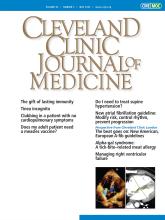ABSTRACT
Analyses of COVID-19 patients with preexisting interstitial lung disease (ILD) or pulmonary sarcoidosis is lacking but registries are ongoing. Treatment of COVID-19 for patients with underlying ILD or sarcoidosis may include hospital admission, possible drug treatment, caution with steroids, and avoidance of mechanical ventilation in acute exacerbation of ILD. Patients with COVID-19 respiratory illness are at risk for developing ILD.
ILD AND COVID-19
About 2% of patients with coronavirus disease 2019 (COVID-19) have concomitant pulmonary disease, which is associated with worse outcomes.1 The US Centers for Disease Control and Prevention (CDC) says that those at higher risk include those with any chronic lung disease or moderate to severe asthma.2 Mechanistically, this makes sense, since coronavirus gains entry into type II pneumocytes through the angiotensin-converting enzyme II receptor,3 and therefore infected patients who have any underlying chronic lung disease would be expected to be at higher risk of severe complications. (Other comorbidities associated with poor outcomes are cardiovascular disease and diabetes.1)
As yet, there have been no analyses of COVID-19 patients with preexisting interstitial lung disease (ILD) or pulmonary sarcoidosis, but registries are ongoing.
Histopathology. In one of the first pathology reports of a patient who died of COVID-19 respiratory failure,4 the lungs demonstrated desquamation of pneumocytes, hyaline membrane formation, and pulmonary edema, ie, the histopathologic picture of diffuse alveolar damage seen in acute respiratory distress syndrome (ARDS). This is very similar to the pathologic picture seen in acute exacerbations of ILD.
Could COVID-19 trigger acute exacerbations of ILD? Although the exact mechanism of acute exacerbation of ILD is not fully understood, the current belief is that it can be caused by numerous triggers, including infection, or it can be idiopathic.5 It is likely that respiratory infection with COVID-19 could trigger an exacerbation of underlying ILD and result in bad outcomes. There is similar concern regarding the possibility of exacerbation in patients with sarcoidosis, especially those with fibrotic manifestations.6
Is immunosuppressive therapy a risk factor? Although the CDC lists it as a risk factor for severe illness with COVID-19,2 there is evidence from the transplant literature that, unlike other viruses such as influenza, coronaviruses do not cause more severe disease in immunosuppressed patients, likely because the host innate immune response appears to be the main source of lung tissue damage.7 Reports from the outbreaks of severe acute respiratory syndrome (SARS), Middle East respiratory syndrome (MERS), and COVID-19 so far have reported no deaths in transplant recipients, patients receiving chemotherapy, or those receiving other immunosuppressive treatments, at any age.1,8,9
HOW SHOULD COVID-19–POSITIVE PATIENTS WITH UNDERLYING ILD OR SARCOIDOSIS BE TREATED?
Hospital admission, supportive care. Because of the risk of severe complications in COVID-19 patients with underlying ILD or sarcoidosis, there should be a low threshold for hospital admission. The current recommendations for treatment of COVID-positive patients involve mostly supportive care including supplemental oxygen, mechanical ventilator support using a lung-protective strategy similar to that used in ARDS, and prone positioning.
Possible drug treatment. Many hospitals, including Cleveland Clinic, solicit guidance from infectious disease physicians regarding when medications such as hydroxychloroquine, lopinavir-ritonavir, compassionate or investigational use of remdesivir, or tocilizumab should be used in moderate to severe illness.
Caution with steroids. There is evidence that giving steroids to patients with SARS and MERS resulted in prolonged viral shedding and worsened clinical outcomes.10 Therefore, the World Health Organization recommends against steroids in COVID-19 except in special cases such as exacerbation of asthma or chronic obstructive pulmonary disease or septic shock.11 Giving antibiotics and steroids in acute exacerbations of ILD has been common practice for many years, but steroid treatment has come under scrutiny as of late, with several trials showing possible harm and increased risk of serious adverse reactions.12,13
Histologically, most acute exacerbations of ILD are characterized by diffuse alveolar damage, while others are characterized by organizing pneumonia, alveolar hemorrhage, and unspecific inflammatory changes. Clinical judgment should be used, and steroids could be considered in cases more likely to respond, such as ILD related to exacerbation of underlying connective tissue disease, which may involve more organizing pneumonia or alveolar hemorrhage.
Consider avoiding mechanical ventilation in acute exacerbations of ILD. The mortality rate in acute exacerbations of ILD alone is greater than 50%,14 and we are currently seeing high mortality rates in COVID-19 patients requiring mechanical ventilation. Therefore strong consideration should be given to avoiding mechanical ventilation and considering palliative measures in a COVID-positive patient with an acute exacerbation of ILD.
PATIENTS WHO DEVELOP COVID-19 RESPIRATORY ILLNESS ARE AT RISK FOR DEVELOPING ILD
As we are still early in this pandemic, not much is known about the long-term outcomes of COVID-19 respiratory infection. Numerous reports from survivors of SARS and MERS describe long-term lung damage and pulmonary fibrosis, resulting in reduced quality of life and significant disability.15 In a 1-year follow-up of SARS survivors, 24% had impaired diffusing capacity for carbon monoxide, and 27.8% had radiographic evidence of interstitial changes or pulmonary fibrosis, or both.16 A 2019 meta-analysis by Sheng at al17 concluded that a number of different viruses are associated with the development of idiopathic pulmonary fibrosis (likely as a trigger rather than the cause). As the pathology and mechanism of infection are similar to those seen in SARS and MERS, one would expect to see similar outcomes of chronic ILD lung disease and reduced pulmonary function in some survivors of COVID-19.
Footnotes
The statements and opinions expressed in COVID-19 Curbside Consults are based on experience and the available literature as of the date posted. While we try to regularly update this content, any offered recommendations cannot be substituted for the clinical judgment of clinicians caring for individual patients.
- Copyright © 2020 The Cleveland Clinic Foundation. All Rights Reserved.






